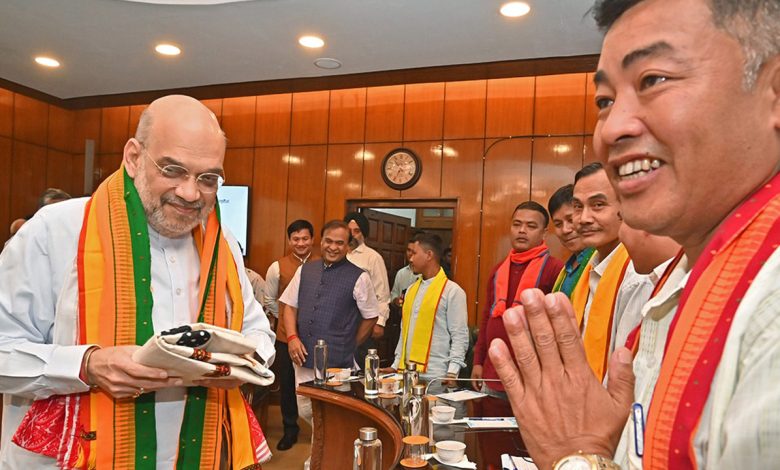
Context- A peace agreement was recently signed by the Dimasa National Liberation Army (DNLA) with the Assam and Union governments.
Key Highlights
- Following an appeal from the chief minister, the DNLA declared a unilateral ceasefire in September 2021 for six months. Since then, the ceasefire has been extended.
What is the goal of this agreement?
- The signing of the Memorandum of Understanding (MoU) requires the DNLA to give up its weapons and abide by the Indian Constitution.
- The group will break up their armed group, leave all camps where DNLA cadres were living, and join the mainstream.
- 179 DNLA cadres will give up their weapons and ammunition.
- The Dimasa tribal areas will receive Rs 500 crore from the central and state governments, respectively, for development.
- Dimasa Government assistance Chamber will be set up by the Public authority of Assam to safeguard, save and advance a social, social, and etymological character to meet political, monetary and instructive desires and will guarantee rapid and centered improvement of the Dimasa public living external the locale of North Cachar Hills Autonomous Council (NCHAC).
- NCHAC runs Dimasa Tribal Region.
- The MoU likewise accommodates the arrangement of a Commission under Passage 14 of the 6th Timetable to the Constitution of India to look at the interest for the consideration of extra towns coterminous to the NCHAC with the Gathering.
- In accordance with Article 244, the Sixth Schedule permits the establishment of autonomous administrative divisions known as Autonomous District Councils (ADCs) within a state that have some legislative, judicial, and administrative autonomy.
DNLA: What is it?
- Assam’s Dima Hasao and Karbi Anglong districts are home to this insurgent group.
- In order to establish a sovereign territory for the Dimasa tribals, the DNLA launched an armed insurgency in April 2019.
- The gathering intends to “foster a feeling of fellowship among the Dimasas and furthermore to remake the trust and confidence among the Dimasa society for recovering the Dimasa Realm”.
- The gathering runs on coercion and tax collection. ” The NSCN(IM) of Nagaland is the source of its funding and sustenance.
About Dimasas
- The Dimasas, also known as Dimasa-Kacharis, are the earliest known rulers and settlers of Assam. They currently reside in the districts of Dima Hasao, Karbi Anglong, Cachar, Hojai, and Nagaon in central and southern Assam, as well as in portions of Nagaland.
- A portion of the students of history depict them as “natives” or the “earliest known occupants of the Brahmaputra Valley”.
- Between the 13th and 16th centuries, Dimasa kings ruled large portions of Assam along the south bank of the Brahmaputra. These Dimasa kings are thought to be the descendants of Kamarupa kings.
- Dimapur, which is now in Nagaland, was their first known capital, followed by Maibang in the North Cachar Hills.
- In the 16th century, it was a powerful kingdom that controlled almost the entire southern Brahmaputra region.
- Protection:
- Dima Hasao region and Karbi Anglong both partake in the 6th Timetable status allowed by the Constitution of India.
- The Karbi Anglong Autonomous Council (KAAC) and the North Cachar Hills Autonomous Council (NCHAC) respectively manage them.
- With the exception of the police and Law & Order, which fall under the Assam Government, almost all government departments are under the control of the Autonomous Council, a powerful body.
How long has there been resistance in Dima Hasao Region?
- Militancy:
- Assam’s hill districts of Dima Hasao and Karbi Anglong have a long history of insurgency by Karbi and Dimasa groups that was fueled by a fundamental demand for statehood and reached its zenith in the middle of the 1990s.
- Along with other tribal groups in undivided Assam, the 1960s saw the beginning of the demand for statehood in Dima Hasao.
- Karbi Anglong and North Cachar remained with Assam on the promise of more government power, including the implementation of Article 244 (A), which allows for an “autonomous state” within Assam in certain tribal areas, despite the formation of new states like Meghalaya. This was never put into action.
- National Security Force of Dimasa:
- An interest for an undeniable state, ‘Dimaraji’, assembled steam, and prompted the development of the assailant Dimasa Public safety Power (DNSF) in 1991.
- In 1995, the group gave up, but Jewel Gorlosa, who was in charge, broke away and formed the Dima Halam Daogah (DHD).
- The DHD began negotiations with the government in 2003, but its chief broke off and formed the DHD-J (Jewel) with Black Widow, an armed group.
- These groups were violent and supported by the general public. They marked a truce in 2012.





.png)



